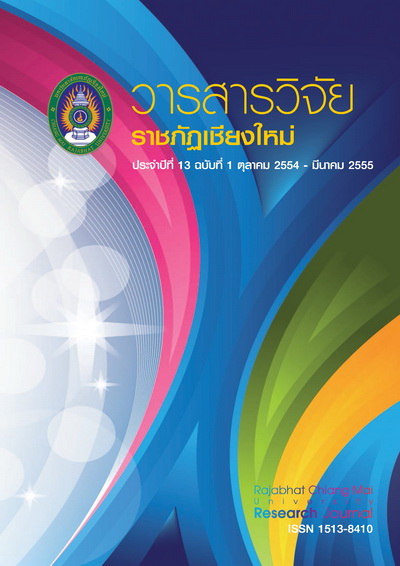ไฮโดรเจนเพอร์ออกไซด์ - สารที่มีประสิทธิภาพ ในการฆ่าเชื้ออาหารเพาะเลี้ยงเนื้อเยื่อพืช
DOI:
https://doi.org/10.14456/rcmrj.2012.96110Keywords:
ไฮโดรเจนเพอร์ออกไซด์, การฆ่าเชื้อ, อาหารเพาะเลี้ยงเนื้อเยื่อ, Hydrogen peroxide, sterilization, Tissue culture mediaAbstract
วิธีการอย่างง่ายในการเตรียมอาหารเพาะเลี้ยงเนื้อเยื่อพืช โดยใช้สารเคมีไฮโดรเจนเพอร์ออกไซด์ (H202 ) แทนการใช้หม้อนึ่งความดันไอนํ้า ได้ถูกพัฒนาขึ้นมาในงานทดลองเพื่อทำการเปรียบเทียบวิธีการแบบดั้งเดิมในการฆ่าเชื้ออาหาร โดยใช้อาหารเพาะเลี้ยงเนื้อเยื่อพืชสูตร Murashige and Skoog, MS (1962) เป็นอาหารพื้นฐานกำหนดให้อาหารที่นึ่งฆ่าเชื้อด้วยหม้อนึ่งความดันไอนํ้าเป็น control เปรียบเทียบกับอาหารที่เติม H2O2(อัตราความเข้มข้น 0, 0.0025, 0.005, 0.075 และ 0.01 เปอร์เซ็นต์ v/v ทำการบันทึกข้อมูลการปนเปีอนเป็นเวลา 17 สัปดาห์ ทำการทดลอง ณ ห้องปฏิบัติการเพาะเลี้ยงเนื้อเยื่อ คณะเทคโนโลยีการเกษตร มหาวิทยาลัยราชภัฏเชียงใหม่ผลการทดลองพบว่า อาหารที่ไม่มีการฆ่าเชื้อเกิดการปนเปีอนเชื้อจุลินทรีย์ตั้งแต่สัปดาห์ที่ 5 และปนเปี้อน 100 เปอร์เซ็นต์เมื่อสัปดาห์ที่ 11 สำหรับอาหารที่ใส่ H2O2(ความเข้มข้น0.0025 เปอร์เซ็นต์ v/v เกิดการปนเปีอนเชื้อจุลินทรีย์ขึ้นในสัปดาห์ที่ 13 และมีการปนเปี้อนเชื้ออย่างต่อเนื่องในสัปดาห์ต่อๆไป ส่วนอาหารที่ฆ่าเชื้อด้วยหม้อนึ่งความดันไอนํ้า อาหารที่เติม H2O2 ความเข้มข้น 0.005 0.075 และ 0.01 เปอร์เซ็นต์ v/v ไม่พบการปนเปี้อนเกิดขึ้นในระยะเวลา 17 สัปดาห์
Hydrogen peroxide - An Effective Agent for the Sterilization of Plant Tissue Culture Media.
Simple sterile culture methods for preparing sterile medium without autoclaving using hydrogen peroxide (H2O2) was developed. เท this work we compared traditional methodology with a protocol that easily to sterilize plant tissue culture media Murashige and Skoog, MS (1962), with additional of H2O2 into plant tissue culture media as chemical sterilizer. A series of H2O2 concentration 0, 0.0025, 0.0050 and 0.0100 % v/v was used to control contamination during 17 weeks experimental period. The results showed that the MS media without H2O2 and supplemented with 0.0025 % v/v H2O2 exhibited many variations with bacterial and fungal contaminations after treatment for 5 and 13 weeks respectively, and the microbial contaminations were continue to increased. While the MS media supplemented with 0.0050, 0.0075 and 0.0100 % v/v H2O2 provided completed sterilization of the medium for 17 weeks experimental period.
Downloads
Downloads
How to Cite
Issue
Section
License
1. Articles, information, content, images, etc published in the “Community and Social Development Journal” are copyrighted by the Community and Social Development Journal, Chiang Mai Rajabhat University. In order to properly distribute the articles through print and electronic media, the authors still hold the copyright for the published articles under the Creative Commons Attribution (CC BY) license, which allows the re-distribution of the articles in other sources. References must be made to the articles in the journal. The authors are responsible for requesting permission to reproduce copyrighted content from other sources.
2. The content of the articles appearing in the journal is the direct responsibility of the article authors. The editorial board of the journal does not necessarily agree with or share any responsibility.














